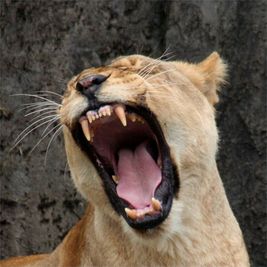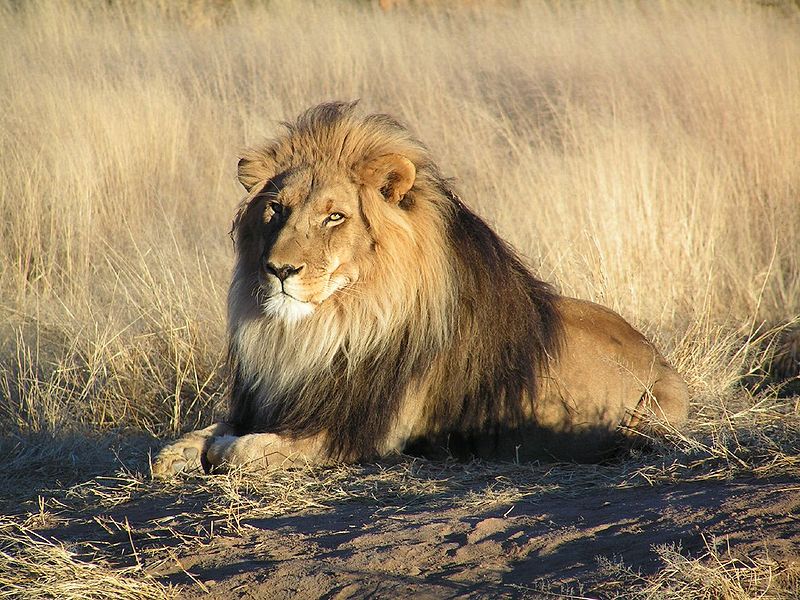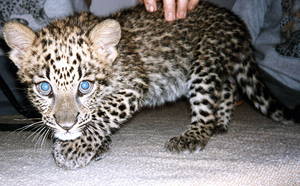The Born Free Foundation
Interview with
Glen - We rescue wild animals that are kept in inhumane conditions all around the world. We try to give them a better quality of life for a few years before they die. I like to describe this sanctuary as a retirement home. We have rescued lions and leopards here. It's cats that were rescued from run-down zoos, circuses, nightclubs. Sadly we cannot rehabilitate them and send them back to the wild. Some of them have lost their canine teeth; some of them their claws have been removed; some of them because they were not fed properly their bone structure didn't develop properly due to lack of exercise and not getting the correct food.
 Meera - If they're going to live here they're going to need a lot of land in order to be comfortable and happy. They've been rescued from bad conditions. How big is the sanctuary here and how much land do they have?
Meera - If they're going to live here they're going to need a lot of land in order to be comfortable and happy. They've been rescued from bad conditions. How big is the sanctuary here and how much land do they have?
Glen - the enclosures here for our rescue cats each you're looking at about 1.5ha and we've left the camps totally natural.
Meera - how do you look after he animals once they're here? They have this 1.5ha of land to live on but what about their diets?
Glen - We feed them twice a week. We feed them with food that we get from our local farmers. Unfortunately they can't hunt for themselves because they were born in captivity.
Meera - How far and wide have you received animals from in the past?
Glen - Some of them came from Romania, Liberia, Sudan, The Ivory Coast, Greece.
Meera - And what about reproduction in these animals? You don't have that much land so you obviously don't want them reproducing?
Glen - Definitely. Especially in captivity, we don't want any cubs born in captivity. What we did - all our male lions have vasectomies - the snip - which means they still mate but there are no cubs born in captivity. The reason why we don't castrate them completely is that the testosterone is responsible for the growth of the mane. If you castrate them the mane falls off. Our lionesses, we put them on contraceptives. The reason for that, why we put them on contraceptives is that the wild lions in Shamwari will pick up their scent when they are in heat. If they are on the contraceptive they don't come into season. That keeps the peace between the animals.
 Meera - In order to understand more about how you look after the animals here you're going to take me on a tour to see a bit of the land...
Meera - In order to understand more about how you look after the animals here you're going to take me on a tour to see a bit of the land...
We've come round the back and Sinbad the lion is here now.
Glen - Sinbad was fed on a diet of pasta and deboned chicken. His bone structure didn't develop properly so he's half the size of a normal lion, because he didn't get the proper diet from an early age and a lack of exercise. He's got no claws. Maybe when he started to scratch people they pulled the claws out. Then he lost his canines too but that was due to frustration while he was kept in that small cage. He was chewing on the metal bars. The canines broke off. They are the same length and height as the molars.
Meera - When the animals come here it must be a change for them because they've been mistreated and things like that. What do you have to do in order to introduce them to the sanctuary?
Glen - At first, before we release them into the big enclosure that's 1.5ha we keep them in a smaller enclosure which we call a hospital camp. That's where they'll acclimatise to the new environment, get used to the electrical fence. They have to dodge the fence to know or to respect the fence. Otherwise they can run straight through it. It's only electrified and it's got about 10,000kV running through it. It won't hurt the animal but just gives them a big shock. Sometimes it can take them up to 3 weeks, sometimes up to 6 weeks just to adapt to this environment. For some of the rescued animals, like Sinbad, that used to stay in a concrete cage; for him it took longer to get used to this environment. He wasn't used to the thorns. He wasn't used to the soil and he had to get used to the bushes and everything, stuff that he never saw, vegetation that he never saw in his life. It took him about three months to get used to this environment.
Meera - I can't stress how close to us this lion is. He's less than a metre away from us but there is a cage in between. He's very well-behaved. He's just sitting here alongside us.
Glen - Definitely. He's totally relaxed. As you can see he's busy just grooming himself but he must still be treated as a wild animal. It's just this fence that's keeping us away from him. Otherwise if we did something silly he could come through and devour us.
Meera - Ok - well I won't be doing that! We've now come round to where they leopard triplets are. They're all - well one of them over here just about a metre in front of us is sitting under a tree because it's very hot. What is the story with these leopards, Glen?
 Glen - These three came from Sudan, found by the soldiers at the age of two weeks in the desert. I'm not sure what happened to the mother. She was probably looking for food or out on a hunt when the soldiers came across these leopards and picked them up and took them back to army camp. They wanted to use them as watch cats, maybe watch dogs at the camp. This one in front of us that's sitting under this tree his name is Elum, keeping cool. Here comes Sammy the dominant male. Hello Sammy.
Glen - These three came from Sudan, found by the soldiers at the age of two weeks in the desert. I'm not sure what happened to the mother. She was probably looking for food or out on a hunt when the soldiers came across these leopards and picked them up and took them back to army camp. They wanted to use them as watch cats, maybe watch dogs at the camp. This one in front of us that's sitting under this tree his name is Elum, keeping cool. Here comes Sammy the dominant male. Hello Sammy.
Meera - He's ignoring you.
Glen - He's just walking up to his brother now. Very social.
Meera - He's got a large area just hanging low from his belly. What's that?
Glen - Our cats, especially with the leopards they've been completely neutered. Once you do that, especially to the males, you remove all the hormones. That's why they get a bit big. They are not as active as a wild lion or leopard. Remember in the wild they will chase things. Here it's a much easier life.
Meera - Did they find it hard to adjust to being here?
Glen - I mean they came here when they were about 5-8 months old. Because they had each other's company probably it was much easier for them than the other rescue cats that came here.
Meera - So Born Free's doing a lot of good work here and looking after these animals. Are there any future developments at Born Free?
Glen - At this stage we're busy developing another centre. It's about 70km away from us. We call it the Gene Bird centre. Born Free's rescuing more cats and lions so we need another home for them. With that centre we can accommodate another 12 animals there now. I'd like to refer to what we're doing as compassionate conservation.
- Previous Safari in Shamwari
- Next The Crisp Packet Fireworks Show!









Comments
Add a comment